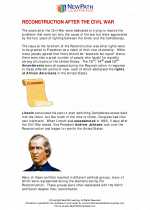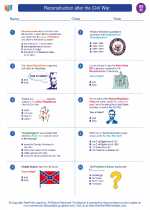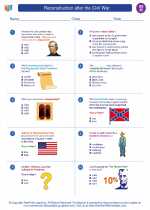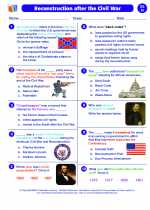Reconstruction after the Civil War
The years after the Civil War were dedicated to trying to resolve the problems that were not only the cause of the war but were aggravated by four years of fighting between the Union and the Confederacy. Read More...
◂Social Studies Worksheets and Study Guides Eighth Grade. Reconstruction after the Civil War
Study Guide Reconstruction after the Civil War
Reconstruction after the Civil War  Worksheet/Answer key
Worksheet/Answer key Reconstruction after the Civil War
Reconstruction after the Civil War  Worksheet/Answer key
Worksheet/Answer key Reconstruction after the Civil War
Reconstruction after the Civil War  Worksheet/Answer key
Worksheet/Answer key Reconstruction after the Civil War
Reconstruction after the Civil War  Worksheet/Answer key
Worksheet/Answer key Reconstruction after the Civil War
Reconstruction after the Civil War 

 Worksheet/Answer key
Worksheet/Answer key
 Worksheet/Answer key
Worksheet/Answer key
 Worksheet/Answer key
Worksheet/Answer key
 Worksheet/Answer key
Worksheet/Answer key

The resources above cover the following skills:
National Curriculum Standards for Social Studies (NCSS)
TIME, CONTINUITY, AND CHANGE
SOCIAL STUDIES PROGRAMS SHOULD INCLUDE EXPERIENCES THAT PROVIDE FOR THE STUDY OF THE PAST AND ITS LEGACY.
KNOWLEDGE - Learners will understand:
Concepts such as: chronology, causality, change, conflict, complexity, multiple perspectives, primary and secondary sources, and cause and effect.
CIVIC IDEALS AND PRACTICES
SOCIAL STUDIES PROGRAMS SHOULD INCLUDE EXPERIENCES THAT PROVIDE FOR THE STUDY OF THE IDEALS, PRINCIPLES, AND PRACTICES OF CITIZENSHIP IN A DEMOCRATIC REPUBLIC.
KNOWLEDGE - Learners will understand:
Key practices involving the rights and responsibilities of citizenship and the exercise of citizenship (e.g., respecting the rule of law and due process, voting, serving on a jury, researching issues, making informed judgments, expressing views on issues, and collaborating with others to take civic action).
National Standards for Civics and Government (NSCG)
What are the foundations of the American political system? What is the American idea of constitutional government?
The American idea of constitutional government. Students should be able to explain the essential ideas of American constitutional government. To achieve this standard, students should be able to
Explain how specific provisions of the United States Constitution, including the Bill of Rights, limit the powers of government in order to protect the rights of individuals, e.g., habeas corpus; trial by jury; ex post facto; freedom of religion, speech, press, and assembly; equal protection of the law; due process of law; right to counsel
How does the government established by the constitution embody the purposes, values, and principles of American democracy? What is the place of law in the American constitutional system?
Judicial protection of the rights of individuals. Students should be able to evaluate, take, and defend positions on current issues regarding judicial protection of individual rights. To achieve this standard, students should be able to
Explain the basic concept of due process of law, i.e., government must use fair procedures to gather information and make decisions in order to protect the rights of individuals and the interests of society
Explain the importance to individuals and to society of major due process protections
Habeas corpus
Presumption of innocence
Fair notice
Impartial tribunal
Speedy and public trials
Right to counsel
Trial by jury
Right against self-incrimination
Protection against double jeopardy
Right of appeal
Explain why due process rights in administrative and legislative procedures are essential for the protection of individual rights and the maintenance of limited government, e.g., the right to adequate notice of a hearing that may affect one's interests, the right to counsel in legislative hearings
What are the roles of the citizen in American democracy? What are the rights of citizens?
Scope and limits of rights. Students should be able to evaluate, take, and defend positions on issues regarding the proper scope and limits of rights. To achieve this standard, students should be able to
Identify and evaluate positions on a contemporary conflict between rights, e.g., right to a fair trial and right to a free press, right to privacy and right to freedom of expression
National Center for History in Schools (NCHS)
Historical Thinking Standards
Historical Comprehension
Reconstruct the literal meaning of a historical passage.
Historical Analysis and Interpretation
Analyze cause-and-effect relationships and multiple causation, including the importance of the individual, the influence of ideas.
United States History Content Standards
Era 5: Civil War and Reconstruction (1850-1877)
How various reconstruction plans succeeded or failed.
The student understands the political controversy over Reconstruction.
The student understands the Reconstruction programs to transform social relations in the South.
The student understands the successes and failures of Reconstruction in the South, North, and West.
Era 6: The Development of the Industrial United States (1870-1900)
The rise of the American labor movement and how political issues reflected social and economic changes.
The student understands how Americans grappled with social, economic, and political issues.
World History Content Standards
Era 7: An Age of Revolutions, 1750-1914
Patterns of nationalism, state-building, and social reform in Europe and the Americas, 1830-1914.
The student understands the political, economic, and social transformations in the Americas in the 19th century.